Your cart is currently empty!
Virginia Mountain Mint Growth Guide
Virginia Mountain Mint is a vigorous, long-lasting plant ideal for wildlife gardens. It attracts pollinators. Read the Quick Growth Guide.
Your cart is currently empty!
The Canada anemone flower is an easy to maintain, dependable and hardy perennial ground cover that produces lovely white buttercup flowers. Because of its rapid growth and adaptability, it would be an ideal choice for those hard-to-grow open spaces in your garden. One of the reasons it makes a great ground cover is because it is an aggressive spreader.
As a summer bloomer, this showy wildflower is perfect for naturalizing in moist areas of a wildflower or native plant garden. In nature, it is found along stream banks, in wet woods, and in moist meadows. It may also be grown near streams, ponds, or water gardens.
Botanical Name: Anemonastrum canadensis
Also Called: Meadow anemone or roundleaf anemone
En français: Anémone du Canada
Colour:
Blooms:
Sun / Shade:
Water: Moist
Soil:
Height:
Pollinators:
Easily grown in average, medium to wet, well-drained soils in full sun to part shade. Prefers moist, humusy soils in part shade, but tolerates full sun in cool summer climates. Avoid windy sites.

Companion plant suggestions include Cardinal flower.
Virginia Mountain Mint is a vigorous, long-lasting plant ideal for wildlife gardens. It attracts pollinators. Read the Quick Growth Guide.
Chamomile tea and green tea are among the 7 teas and herbs that reduce anxiety and improve sleep which we discuss here.
We give you many options to get rid of aphids naturally. Control and stop leaf piercing and eating pests on your outdoor and indoor plants.
Discover expert recommendations for your fall garden. Learn about planting bulbs, storing dahlias, overwintering annuals, and more for a beautiful spring garden.
Choose 10 of the best bulbs to bring brilliant spring color to your garden! From fragrant Hyacinth to stately Allium, bring joy to early spring with Winter Aconite, Tulips, Crocus, Glory of the Snow and more. Plant before October to ensure stunning blooms.
Collect seeds from heritage or open-pollinated tomatoes. With seeds from hybrid tomatoes, there is no telling what tomato will come.
GardeningCalendar.ca gets some funding from advertisers. If you click on links and advertisements at no cost to you, the site may receive a small commission that helps fund its operation.
© 2025 J&S Calendars Ltd.
Leave a Reply
You must be logged in to post a comment.